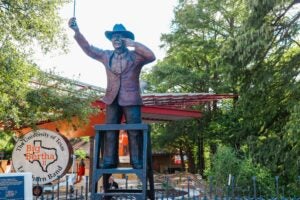AUSTIN, Texas—A transportation engineer at The University of Texas at Austin has performed one of the most comprehensive surveys of physical activity in children and found that about as many kids stay active by pedaling their bikes to a friend’s house or walking around a neighborhood as do others by participating in organized athletics.
“This is a compelling reminder that parents really don’t need to think of staying fit as a huge and scheduled time sink,” said Dr. Chandra Bhat. “You can, in simple, flexible ways, change a child’s lifestyle to incorporate physical activity.”

|
| Dr. Chandra Bhat, associate professor of civil, architectural and environmental engineering, has performed one of the most comprehensive surveys of exercise in children and found that as many kids stay active by peddling to a friend’s or walking their neighborhood as do others by participating in organized athletics. |
| Photo: Jennie Trower |
The professor and a graduate student will describe the study results on Monday, Jan. 23, at the 85th annual meeting of the Transportation Research Board in Washington D.C. The talk is based on an analysis Bhat and graduate student Rachel Copperman performed on a 2001 survey about travel choices made by 15,000 households in the San Francisco Bay area.
Recent studies have found that children are exercising less, and becoming more obese. About one in eight American children bike or walk to school, for instance, as compared to one in two children 30 years ago. The percentage of children who are overweight has more than doubled in the same time frame.
The survey Bhat used was based on weekend activities in nine Bay area counties. One of his goals was to determine whether the physical structures that favor exercise in neighborhoods influence the physical activity levels of children between five and 17 years of age.
“The built environment, how we design our cities and neighborhoods, seemed to help,” said Bhat, who holds the Fluor Centennial Teaching Fellowship in Engineering No. 1. “But our ability to influence physical activity through the built environment is rather limited.
“Overall, it seems the demographic and social issues, and possibly attitudes toward exercise, impact physical activity participation in children more substantially.”
He noted that public attitudes have been shown to impact behavior, so that “changing the built environment to make it more conducive to walking and other activities, while increasing awareness of the benefits of being active, could bring significant benefits for children’s health.”
Bhat’s analysis revealed that 32 percent of Bay area children participated in some form of physical activity during the day on weekends. Boys were about 25 percent more likely than girls to exercise as part of daily activities or recreationally. This may reflect developmental differences between boys and girls, such as a differing maturation of motor skills. Or it may result from a culture-driven emphasis on sports and physical activity for boys, and on participating in more varied activities for girls, Bhat said.
The study also revealed that not all ethnic groups participated in physical activity to the same extent or in the same way. Overall, children of Asian origin participated the least in physical activity, primarily because they were more likely to take a car between activities rather than bike or walk to activity locations (called utilitarian physical activity). Caucasian children were more likely than other non-Asian children to use the car between activities, but were also slightly more likely than all other ethnic groups to participate in recreational physical activity (biking or walking around a neighborhood or playing in organized sports).
Hispanic children were the least likely of any ethnic group to use the car to access activities, but participated in recreational exercise at a comparable rate to other ethnicities. Thus, they had the highest overall physical activity participation rates.
Children in predominantly African American neighborhoods tended not to bike or walk around their neighborhood or to activity locations, and also participated in organized forms of exercise less often on average than children in other neighborhoods.
Bhat noted that the 2001 survey didn’t address family decision-making, so differences in beliefs about the safety of outdoor exercise, or the benefits of exercise, could not be addressed. Also, while the layout of streets and access to recreational facilities were considered, factors such as the quality of streets and crime rates in neighborhoods were not considered because precise data weren’t available for all of the 738 rural and 361 urban locations analyzed.
“It could be that some neighborhoods don’t have good facilities for exercising—that they don’t have walkways or good quality parks around the neighborhoods,” he said.
Rural children seemed to face another impediment. They rarely walked or bicycled to locations, perhaps because they were too far away to reach easily without a car.
Regardless of such physical constraints, Bhat said, the way families approached exercise seemed to matter. If a household had bicycles, the children were three times as likely to bike or walk around the neighborhood for recreation, and about twice as likely to be involved in organized athletics and walk/bike to activity locations. Families with many cars had children who rarely walked or biked to reach activities, though they had an average level of sports participation.
The civil engineers also estimated the impact of adding exercise-enticing features to a neighborhood, and found they provided modest benefits. The study showed that increasing the number of bike lanes by 25 percent might increase the time spent in recreational travel in a neighborhood by 15 percent. Concurrently, the time kids spent walking or biking around their neighborhood would then drop about 1 percent. As a result, their overall physical activity levels only increased about 2 percent.
A similar outcome was suggested if 25 percent more restaurants or convenience stores existed within a mile of a neighborhood. In this case, utilitarian travel jumped and recreational exercise dipped.
“There are tradeoffs, and it is important to consider utilitarian exercise and recreational activity together,” Bhat said, noting that this study is one of few to have done so.
Bhat and a graduate student will give a talk later on Jan. 23 at the meeting about another study on seat belts and drivers’ safety. A summary of those study findings can be found online.
For more information contact: Becky Rische, College of Engineering, 512-471-7272.



